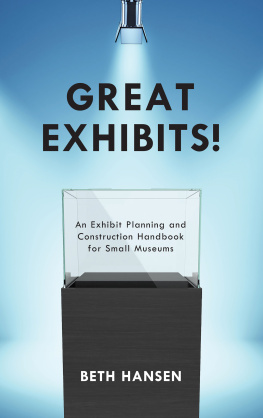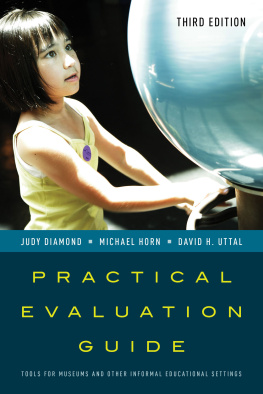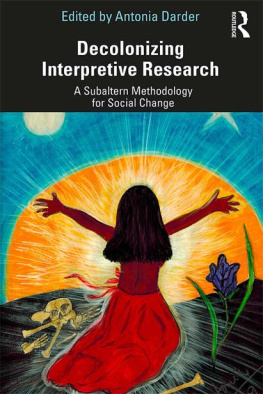INTERPRETIVE PLANNING FOR MUSEUMS
INTERPRETIVE PLANNING FOR MUSEUMS
Integrating Visitor Perspectives in Decision Making
Marcella Wells, Barbara Butler, and Judith Koke
First published in 2013 by Left Coast Press, Inc.
Published 2016 by Routledge
2 Park Square, Milton Park, Abingdon, Oxon OX14 4RN
711 Third Avenue, New York, NY 10017, USA
Routledge is an imprint of the Taylor & Francis Group, an informa business.
Copyright 2013 Taylor & Francis
All rights reserved. No part of this book may be reprinted or reproduced or utilised in any form or by any electronic, mechanical, or other means, now known or hereafter invented, including photocopying and recording, or in any information storage or retrieval system, without permission in writing from the publishers.
Notice:
Product or corporate names may be trademarks or registered trademarks, and are used only for identification and explanation without intent to infringe.
Library of Congress Cataloging-in-Publication Data:
Wells, Marcella D, 1953-
Interpretive planning for museums : integrating visitor perspectives in decision making / Marcella Wells, Barbara Butler, and Judith Koke.
pages cm
Includes bibliographical references and index.
ISBN 978-1-61132-156-2 (hardback : alkaline paper) ISBN 978-1-61132-157-9 (paperback : alkaline paper) ISBN 978-1-61132-158-6 (institutional eBook) ISBN 978-1-61132-673-4 (consumer eBook)
1. MuseumsPlanningDecision making. 2. Interpretation of cultural and natural resourcesPlanningDecision making. 3. Museum visitorsAttitudes. 4. MuseumsSocial aspects. 5. MuseumsEducational aspects. I. Butler, Barbara H. II. Koke, Judith, 1958- III. Title.
AM121.W45 2012
069dc23
2012035359
ISBN 978-1-61132-157-9 paperback
ISBN 978-1-61132-156-2 hardback



This book started on a cocktail napkin. Following our 2001 workshop called Understanding VisitorsThe How and Why of Visitor Research, two of us, Barbara and Marcella, met for happy hour, and The Triangle was conceived over drinks. This triangle developed into our Outcomes Hierarchy: a model that arrays visitor experience outcomes in progressive tiers of a triangle and is designed to help museum practitioners plan, and consider the effects of, their interpretive efforts. In 2002, we published the hierarchy as the Visitor-Centered Evaluation Hierarchy in an article in Visitor Studies Today! (Wells and Butler 2002); a second article, in which we revised the hierarchy slightly, appeared in The Public Garden (Wells and Butler 2004). No fewer than a dozen revisions and refinements later, the Outcomes Hierarchy serves as the centerpiece of this book. In our discussion here, however, we take the hierarchy a step further by exploring its usefulness for integrating visitor perspectives in interpretive planning for museums.
Often visitor research and interpretive planning are pursued independently of one another. On the one hand, visitor studies specialists are interested in how their evaluation results will be used to achieve more effective visitor experiences. On the other hand, educators and interpretive planners are interested in, but are sometimes uncertain about, how to pursue or apply visitor studies. Our discussion and recommendations are intended to help informal learning institutions integrate visitor perspectives into interpretive planning by drawing strongly on the Outcomes Hierarchy. We hope that readers will hold the hierarchy in their minds as they encounter crucial moments of decision throughout the process of planning visitor experiences. Although this book is not specifically about evaluation, it aims to ensure that visitor perspectives are considered throughout planning. Our emphasis on the importance of integrating visitor perspectives into the practice of interpretive planning is based on the belief that the greater our understanding and use of visitor perspectives and input, the more likely we are to develop and realize relevant and engaging programs and exhibitions.
We three authors all are fortunate to have had careers that span multiple disciplines that, in turn, support an integrated approach to visitor experience planning. We have spent our professional lives questioning: What can we learn from visitors and our communities that will help us develop a successful project and document our success? How do desired outcomes help shape a project? How do we decide what to eliminate in tight budget or schedule situations? We advocate for thoughtful and intentional interpretive planning that integrates visitor perspectives, believing that this approach is the next step in working with, rather than for, our communities, a step toward becoming truly visitor-centered and effective as essential learning institutions of the twenty-first century.
Examples of interpretive plans in museums are somewhat rare at present. We hope that this book will ignite enthusiasm for planning and stimulate increased interest and practice in a more integrated approach to planning visitor experiences. We would like this to be the beginning of a dialogue with our colleagues, and so we welcome contact, critique, and discussion. Perhaps a revised edition will shortly be required as this dialogue continues.
Sincere thanks go to our reviewers, Daryl Fischer, Charlie Walter, and Kelly McKinley, for providing valuable feedback on drafts of this book. Their perspectives on our perspectives proved immensely helpful in clarifying our ideas. Second, we would like to thank our graphic artists, Sue Sell and Michelle Cerise, and illustrator Mickey Schilling for their parts in creating images that aid readers in visualizing our ideas. Third, we want to thank the institutions that granted us permission to use excerpts from their interpretive plans as examples in the latter chapters of the book and Appendix B. Finally, we thank our respective husbands, Alan and the two Glenns, for their patience and encouragement throughout the books genesis.
A well-established, successful, midsize history museum begins a process for mounting a new permanent exhibition. Having received a planning grant from a national foundation, the curatorial and education staff meet to begin planningin this case, beginning with a topic, a list of possible objects and photos from the collections, and a brief content outline.
As the staff continues to develop the objects list and content outline, planners contract with a local exhibit design firm to develop schematic ideas and eventual design drawings. Some weeks later they hire an evaluator to conduct an evaluation of exhibit concepts and possible interactive elements. A few months later they submit a planning grant report to the foundation containing a theme document, design drawings, object lists, final label copy, and the evaluation report.














